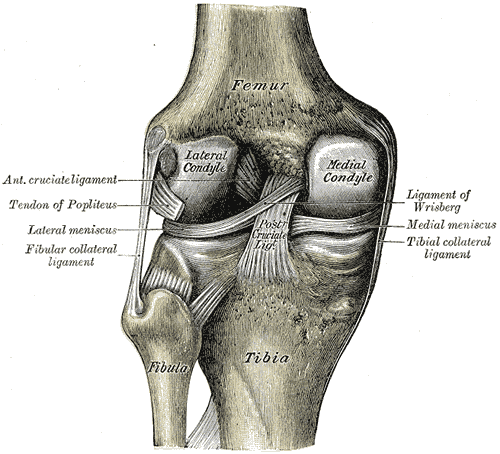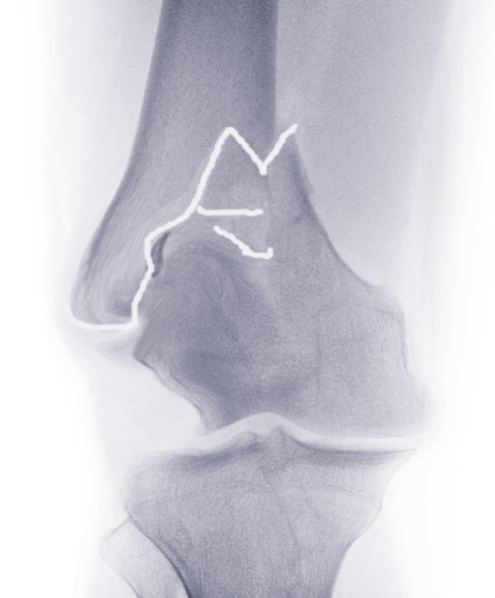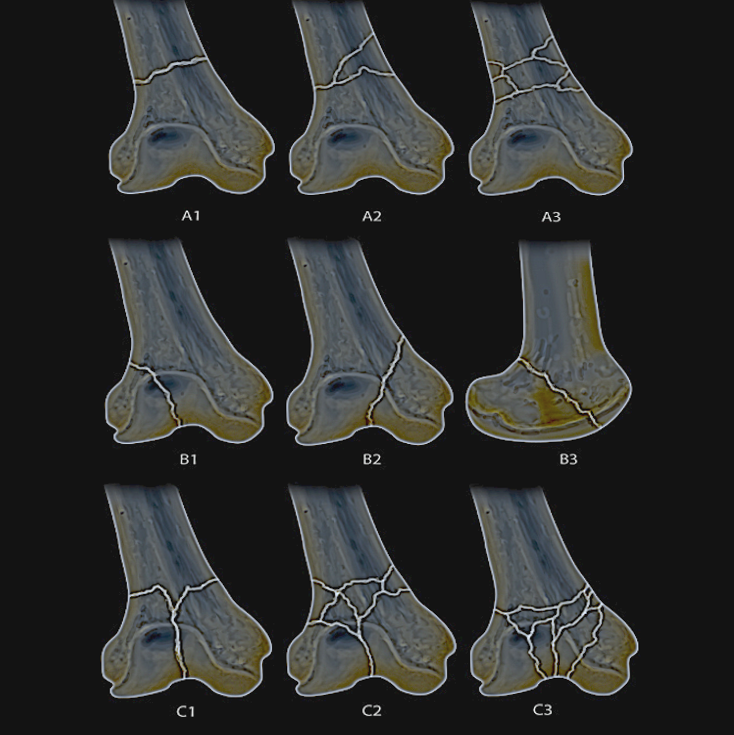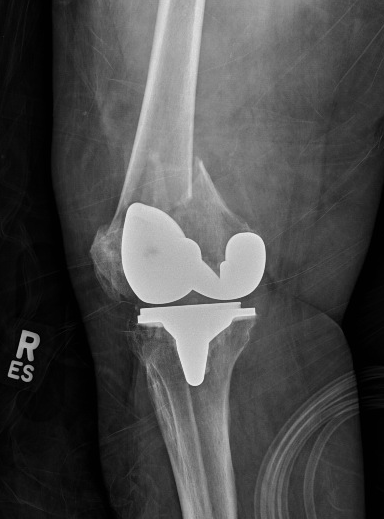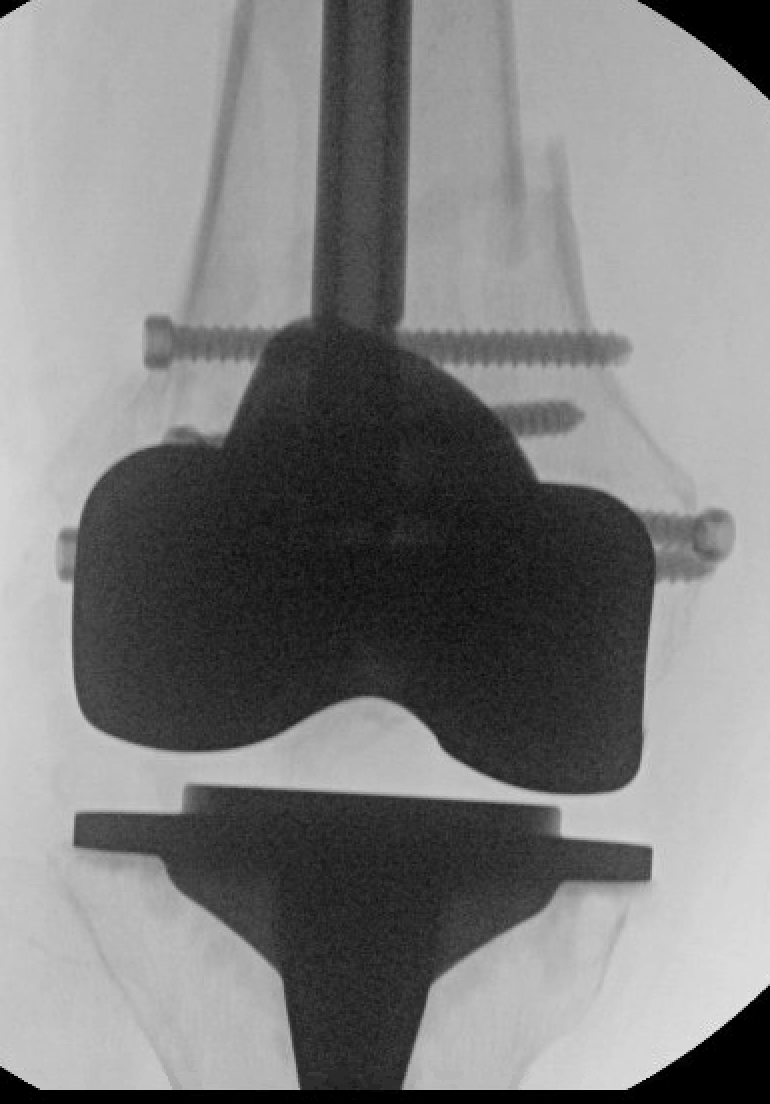[1]
Martinet O, Cordey J, Harder Y, Maier A, Bühler M, Barraud GE. The epidemiology of fractures of the distal femur. Injury. 2000 Sep:31 Suppl 3():C62-3
[PubMed PMID: 11052383]
[2]
Adams AJ, Mahmoud MAH, Wells L, Flynn JM, Arkader A. Physeal fractures of the distal femur: does a lower threshold for surgery lead to better outcomes? Journal of pediatric orthopedics. Part B. 2020 Jan:29(1):40-46. doi: 10.1097/BPB.0000000000000664. Epub
[PubMed PMID: 31425335]
[3]
Shields E, Behrend C, Bair J, Cram P, Kates S. Mortality and Financial Burden of Periprosthetic Fractures of the Femur. Geriatric orthopaedic surgery & rehabilitation. 2014 Dec:5(4):147-53. doi: 10.1177/2151458514542281. Epub
[PubMed PMID: 26246936]
[5]
Zlowodzki M, Bhandari M, Marek DJ, Cole PA, Kregor PJ. Operative treatment of acute distal femur fractures: systematic review of 2 comparative studies and 45 case series (1989 to 2005). Journal of orthopaedic trauma. 2006 May:20(5):366-71
[PubMed PMID: 16766943]
Level 2 (mid-level) evidence
[6]
Arneson TJ, Melton LJ 3rd, Lewallen DG, O'Fallon WM. Epidemiology of diaphyseal and distal femoral fractures in Rochester, Minnesota, 1965-1984. Clinical orthopaedics and related research. 1988 Sep:(234):188-94
[PubMed PMID: 3409576]
[7]
Della Rocca GJ, Leung KS, Pape HC. Periprosthetic fractures: epidemiology and future projections. Journal of orthopaedic trauma. 2011 Jun:25 Suppl 2():S66-70. doi: 10.1097/BOT.0b013e31821b8c28. Epub
[PubMed PMID: 21566478]
[8]
Butt WP, Samuel E. Radiologic anatomy of the proximal end of the femur. Journal of the Canadian Association of Radiologists. 1966 Jun:17(2):103-6
[PubMed PMID: 5945612]
[9]
Green NE, Allen BL. Vascular injuries associated with dislocation of the knee. The Journal of bone and joint surgery. American volume. 1977 Mar:59(2):236-9
[PubMed PMID: 845209]
[10]
Morwood MP, Gebhart SS, Zamith N, Mir HR. Outcomes of fixation for periprosthetic tibia fractures around and below total knee arthroplasty. Injury. 2019 Apr:50(4):978-982. doi: 10.1016/j.injury.2019.03.014. Epub 2019 Mar 15
[PubMed PMID: 30929804]
[11]
Dugan TR, Hubert MG, Siska PA, Pape HC, Tarkin IS. Open supracondylar femur fractures with bone loss in the polytraumatized patient - Timing is everything! Injury. 2013 Dec:44(12):1826-31. doi: 10.1016/j.injury.2013.03.018. Epub 2013 Apr 16
[PubMed PMID: 23601115]
[12]
Zalavras CG, Patzakis MJ. Open fractures: evaluation and management. The Journal of the American Academy of Orthopaedic Surgeons. 2003 May-Jun:11(3):212-9
[PubMed PMID: 12828451]
[13]
Boyce RH, Singh K, Obremskey WT. Acute Management of Traumatic Knee Dislocations for the Generalist. The Journal of the American Academy of Orthopaedic Surgeons. 2015 Dec:23(12):761-8. doi: 10.5435/JAAOS-D-14-00349. Epub 2015 Oct 22
[PubMed PMID: 26493970]
[14]
Pennock AT, Ellis HB, Willimon SC, Wyatt C, Broida SE, Dennis MM, Bastrom T. Intra-articular Physeal Fractures of the Distal Femur: A Frequently Missed Diagnosis in Adolescent Athletes. Orthopaedic journal of sports medicine. 2017 Oct:5(10):2325967117731567. doi: 10.1177/2325967117731567. Epub 2017 Oct 10
[PubMed PMID: 29051906]
[15]
Nork SE, Segina DN, Aflatoon K, Barei DP, Henley MB, Holt S, Benirschke SK. The association between supracondylar-intercondylar distal femoral fractures and coronal plane fractures. The Journal of bone and joint surgery. American volume. 2005 Mar:87(3):564-9
[PubMed PMID: 15741623]
[16]
Inaba K, Potzman J, Munera F, McKenney M, Munoz R, Rivas L, Dunham M, DuBose J. Multi-slice CT angiography for arterial evaluation in the injured lower extremity. The Journal of trauma. 2006 Mar:60(3):502-6; discussion 506-7
[PubMed PMID: 16531846]
[17]
Gwathmey FW Jr, Jones-Quaidoo SM, Kahler D, Hurwitz S, Cui Q. Distal femoral fractures: current concepts. The Journal of the American Academy of Orthopaedic Surgeons. 2010 Oct:18(10):597-607
[PubMed PMID: 20889949]
[18]
Cass J, Sems SA. Operative versus nonoperative management of distal femur fracture in myelopathic, nonambulatory patients. Orthopedics. 2008 Nov:31(11):1091
[PubMed PMID: 19226094]
[19]
Parekh AA, Smith WR, Silva S, Agudelo JF, Williams AE, Hak D, Morgan SJ. Treatment of distal femur and proximal tibia fractures with external fixation followed by planned conversion to internal fixation. The Journal of trauma. 2008 Mar:64(3):736-9. doi: 10.1097/TA.0b013e31804d492b. Epub
[PubMed PMID: 18332816]
[20]
Kolb K, Grützner P, Koller H, Windisch C, Marx F, Kolb W. The condylar plate for treatment of distal femoral fractures: a long-term follow-up study. Injury. 2009 Apr:40(4):440-8. doi: 10.1016/j.injury.2008.08.046. Epub 2009 Mar 13
[PubMed PMID: 19285670]
[21]
Huang HT, Huang PJ, Su JY, Lin SY. Indirect reduction and bridge plating of supracondylar fractures of the femur. Injury. 2003 Feb:34(2):135-40
[PubMed PMID: 12565021]
[22]
Canadian Orthopaedic Trauma Society. Are Locking Constructs in Distal Femoral Fractures Always Best? A Prospective Multicenter Randomized Controlled Trial Comparing the Less Invasive Stabilization System With the Minimally Invasive Dynamic Condylar Screw System. Journal of orthopaedic trauma. 2016 Jan:30(1):e1-6. doi: 10.1097/BOT.0000000000000450. Epub
[PubMed PMID: 26429408]
Level 1 (high-level) evidence
[23]
Higgins TF, Pittman G, Hines J, Bachus KN. Biomechanical analysis of distal femur fracture fixation: fixed-angle screw-plate construct versus condylar blade plate. Journal of orthopaedic trauma. 2007 Jan:21(1):43-6
[PubMed PMID: 17211268]
[24]
McDonald TC, Lambert JJ, Hulick RM, Graves ML, Russell GV, Spitler CA, Bergin PF. Treatment of Distal Femur Fractures With the DePuy-Synthes Variable Angle Locking Compression Plate. Journal of orthopaedic trauma. 2019 Sep:33(9):432-437. doi: 10.1097/BOT.0000000000001510. Epub
[PubMed PMID: 31259799]
[25]
Ricci WM, Streubel PN, Morshed S, Collinge CA, Nork SE, Gardner MJ. Risk factors for failure of locked plate fixation of distal femur fractures: an analysis of 335 cases. Journal of orthopaedic trauma. 2014 Feb:28(2):83-9. doi: 10.1097/BOT.0b013e31829e6dd0. Epub
[PubMed PMID: 23760176]
Level 3 (low-level) evidence
[26]
Vallier HA, Hennessey TA, Sontich JK, Patterson BM. Failure of LCP condylar plate fixation in the distal part of the femur. A report of six cases. The Journal of bone and joint surgery. American volume. 2006 Apr:88(4):846-53
[PubMed PMID: 16595476]
Level 3 (low-level) evidence
[27]
Leung KS, Shen WY, So WS, Mui LT, Grosse A. Interlocking intramedullary nailing for supracondylar and intercondylar fractures of the distal part of the femur. The Journal of bone and joint surgery. American volume. 1991 Mar:73(3):332-40
[PubMed PMID: 2002070]
[28]
Butler MS, Brumback RJ, Ellison TS, Poka A, Bathon GH, Burgess AR. Interlocking intramedullary nailing for ipsilateral fractures of the femoral shaft and distal part of the femur. The Journal of bone and joint surgery. American volume. 1991 Dec:73(10):1492-502
[PubMed PMID: 1748698]
[29]
Wähnert D, Hoffmeier KL, von Oldenburg G, Fröber R, Hofmann GO, Mückley T. Internal fixation of type-C distal femoral fractures in osteoporotic bone. The Journal of bone and joint surgery. American volume. 2010 Jun:92(6):1442-52. doi: 10.2106/JBJS.H.01722. Epub
[PubMed PMID: 20516320]
[30]
Hoskins W, Sheehy R, Edwards ER, Hau RC, Bucknill A, Parsons N, Griffin XL. Nails or plates for fracture of the distal femur? data from the Victoria Orthopaedic Trauma Outcomes Registry. The bone & joint journal. 2016 Jun:98-B(6):846-50. doi: 10.1302/0301-620X.98B6.36826. Epub
[PubMed PMID: 27235531]
[31]
Benum P. The use of bone cement as an adjunct to internal fixation of supracondylar fractures of osteoporotic femurs. Acta orthopaedica Scandinavica. 1977 May:48(1):52-6
[PubMed PMID: 868487]
[32]
Struhl S, Szporn MN, Cobelli NJ, Sadler AH. Cemented internal fixation for supracondylar femur fractures in osteoporotic patients. Journal of orthopaedic trauma. 1990:4(2):151-7
[PubMed PMID: 2358929]
[33]
Nizegorodcew T, Palmieri G, Peruzzi M, Galli M. Allograft for the treatment of traumatic severe bone loss in the lateral femoral condyle: A case report. Injury. 2018 Dec:49 Suppl 4():S16-S20. doi: 10.1016/j.injury.2018.11.037. Epub 2018 Dec 3
[PubMed PMID: 30526946]
Level 3 (low-level) evidence
[34]
Loosen A, Fritz Y, Dietrich M. Surgical Treatment of Distal Femur Fractures in Geriatric Patients. Geriatric orthopaedic surgery & rehabilitation. 2019:10():2151459319860723. doi: 10.1177/2151459319860723. Epub 2019 Jul 2
[PubMed PMID: 31308992]
[35]
Myers P, Laboe P, Johnson KJ, Fredericks PD, Crichlow RJ, Maar DC, Weber TG. Patient Mortality in Geriatric Distal Femur Fractures. Journal of orthopaedic trauma. 2018 Mar:32(3):111-115. doi: 10.1097/BOT.0000000000001078. Epub
[PubMed PMID: 29462121]
[36]
Thomson AB, Driver R, Kregor PJ, Obremskey WT. Long-term functional outcomes after intra-articular distal femur fractures: ORIF versus retrograde intramedullary nailing. Orthopedics. 2008 Aug:31(8):748-50
[PubMed PMID: 18714768]
[37]
Hartin NL, Harris I, Hazratwala K. Retrograde nailing versus fixed-angle blade plating for supracondylar femoral fractures: a randomized controlled trial. ANZ journal of surgery. 2006 May:76(5):290-4
[PubMed PMID: 16768683]
Level 1 (high-level) evidence
[38]
Collinge CA, Gardner MJ, Crist BD. Pitfalls in the application of distal femur plates for fractures. Journal of orthopaedic trauma. 2011 Nov:25(11):695-706. doi: 10.1097/BOT.0b013e31821d7a56. Epub
[PubMed PMID: 21857537]
[39]
Sanders R, Swiontkowski M, Rosen H, Helfet D. Double-plating of comminuted, unstable fractures of the distal part of the femur. The Journal of bone and joint surgery. American volume. 1991 Mar:73(3):341-6
[PubMed PMID: 2002071]
[40]
Bellabarba C, Ricci WM, Bolhofner BR. Indirect reduction and plating of distal femoral nonunions. Journal of orthopaedic trauma. 2002 May:16(5):287-96
[PubMed PMID: 11972070]
[41]
Kregor PJ, Stannard JA, Zlowodzki M, Cole PA. Treatment of distal femur fractures using the less invasive stabilization system: surgical experience and early clinical results in 103 fractures. Journal of orthopaedic trauma. 2004 Sep:18(8):509-20
[PubMed PMID: 15475846]
[42]
Moore TJ, Watson T, Green SA, Garland DE, Chandler RW. Complications of surgically treated supracondylar fractures of the femur. The Journal of trauma. 1987 Apr:27(4):402-6
[PubMed PMID: 3553608]

